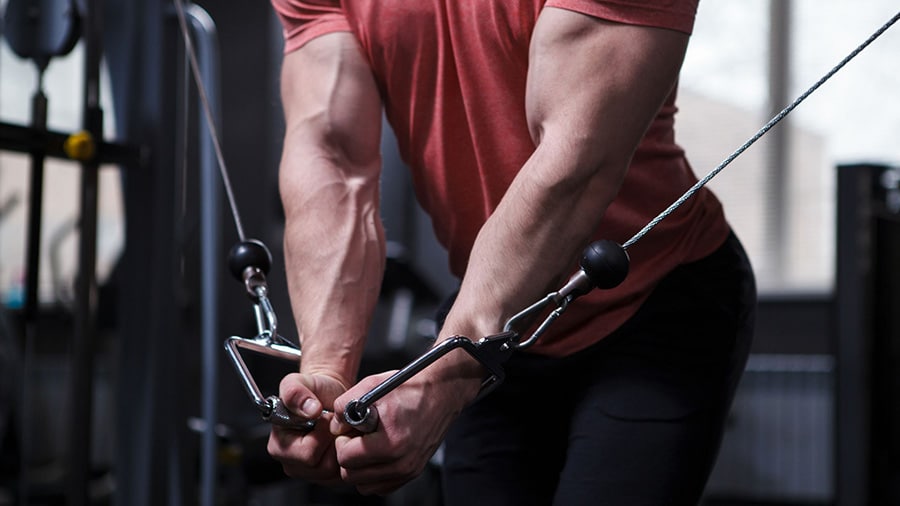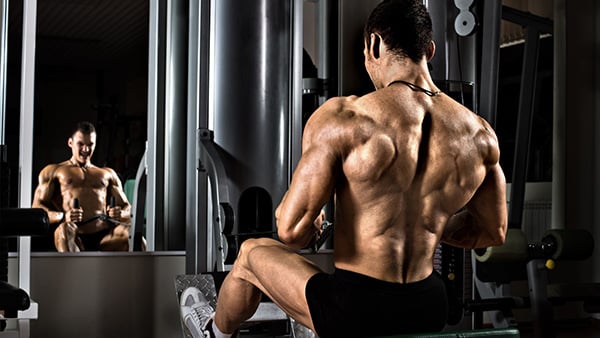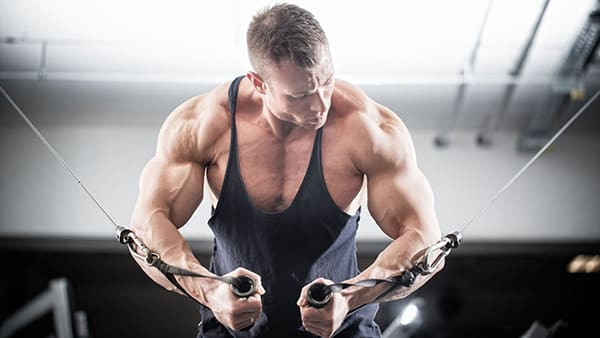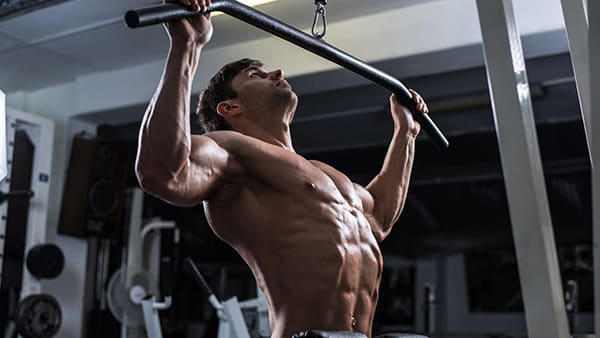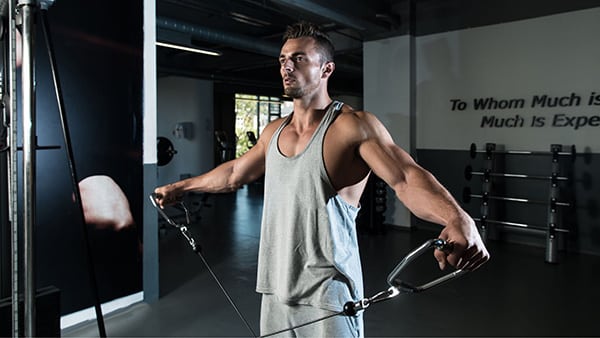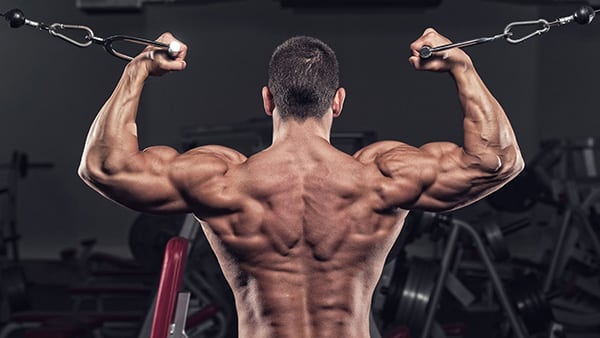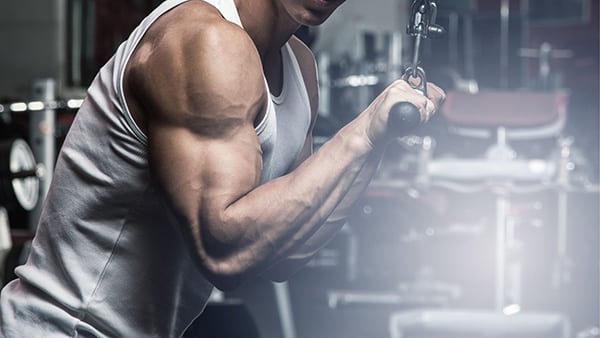The body-building pulley is a versatile tool that every exerciser should include in their training program. Found in most fitness studios, it can be used to train all muscle groups. Unlike free weights, the pulley system has the advantage of making it possible to work on all muscle groups. in DC voltage. This last point is essential, as it promotes muscle fiber recruitment. Discover 19 pulley exercises to strengthen the whole body.
What is a bodybuilding pulley?
If you attend a weight roomIt's a safe bet that you've already come across a pulley machine.
This device consists of a tower to which a block of adjustable weights is attached. These weights, in turn, are attached to a carabiner by means of a cable robust. It's this mechanism that offers you greater or lesser resistance, depending on the weight you choose, on your pulling movements.
There are two main types of pulley: the single pulley and the double pulley.
In addition, different types of handles can be attached to the carabiner: EZ bar, rope, double rowing handle, triceps bar, side bar, back bar, V-bar, etc.
To realize various strength exercisesThe height of the pulley can be adjusted on the tower. Depending on its position, it is referred to as a high or low pulley.
Finally, a weight station consisting of two towers is known as a pulley opposite. A few metres separate the two ends, which are connected by a support that often acts as a pull rod.
The advantages of the pulley in bodybuilding
A bodybuilding pulley offers many advantages:
- A wide variety of exercises;
- Continuous tension throughout the movement;
- Working in isolation ;
- Safe practice.
Variety of exercises
Thanks to its versatility, you can perform countless bodybuilding exercises with the pulley. You could perform a complete training with this device.
Whether you want to work your back muscles, arms, shoulders or pectorals, you can do it with a pulley machine. We'll come back to this later in the article, with examples of exercises for each muscle group. muscle group.
Depending on the muscles you are targeting, you can adjust the pulley height (low pulley or high pulley) and the load used, usually in 2.5 kg increments.
DC voltage
Unlike free weights (barbell and dumbbell), the bodyweight pulley exerts resistance throughout the movement, both in the eccentric and concentric parts.
The muscle being worked is therefore solicited from start to finish. In fact, this is what makes the pulley so effective in terms of muscle congestion.
Working in isolation
Pulley exercises are mainly isolation movementsAs opposed to the basic exercises such as the squat, bench press or deadlift.
Isolation exercises are designed to recruit a single muscle. For this reason, pulley work is essentially integrated into the end of trainingafter the basic movements.
In this sense, the use of a pulley is an excellent way to bulk up harmoniously, to catch up or to make up for lost time. correct an asymmetry.
Safety
As a sports coachA lot of users ask me how to use the bodybuilding pulley.
Of course, there are as many ways to use it as there are exercises.
However, it has a twofold advantage: it is accessible to all, even beginners, and it allows you to practice in complete safety.
In fact, the pulley is ideal for building muscle, while limiting the stress on muscles and joints, and therefore injuries.
The best pulley exercises by muscle group
Looking to include the pulley in your bodybuilding program?
Here is 19 exercises to optimize your muscle development.
Would you like to follow a bodybuilding program to reach your goals?
3 pulley exercises for pectoral muscles
- Facing pulley splits The butterfly: this standing movement is one of the best pectoral exercises on the pulley. It's a variation on the butterfly or dumbbell splits, offering a better resistance curve. You can do this split on the high pulley to recruit the lower part of the pectorals, or on the low pulley to target the upper part.
- Prone splits Bench press: for this exercise, you'll need a weight bench to place in the middle of the station, and simple handles. Lying on the bench, with the pulleys in the down position, you'll need to bring your hands over your torso.
- Inclined bench press with pulley incline the bench at 45 degrees, as for a dumbbell incline press. Set the pulley in the down position, grasp the handles and extend your arms upwards.
3 pulley exercises for the back
- Vertical pulley pull Chest pull: also known as the chest pull, this movement stimulates the back muscles. To optimize recruitment of the back muscles, don't hesitate to vary the position of the hands, using different grips (wide bar, V-bar, etc.).
- Horizontal pulling Pulley rowing: another pulley exercise for the back. For this rowing exercise, make sure you keep your back straight throughout the movement, and bring your elbows back along your ribs. Here again, you can vary the position and spacing of your hands, and even work unilaterally.
- Pulley pullover Back squat: excellent for developing the long back, this movement is performed standing with a rope or bar attached to a high pulley. With your torso bent forward and arms straight, bring your elbows to your sides.
3 pulley exercises for the shoulders
- Internal and external rotations Often used as a warm-up before a weight-training session, this exercise is excellent for the health of your shoulders, and in particular for the rotator cuff. Caution: rotations must be performed with a light load.
- The side elevations This movement is ideal for recruiting deltoid muscles. Unlike the dumbbell version, it provides constant tension throughout the exercise.
- The face pullover Now for an exercise to strengthen the posterior shoulder fascicle, a part of the body neglected by many exercisers. The face pull is performed with a rope at head height. The aim is to grasp the rope and pull it towards your face, squeezing your shoulder blades.
3 pulley exercises for biceps
- The biceps curl Biceps curl: this low pulley arm exercise is an excellent alternative to the classic biceps curl. With a straight bar in supine grip or a rope in neutral grip, this movement will enable you to isolate the work of the biceps.
- The bicep curl this movement combines all the advantages of pulley work with those of the Larry Scottone of the best exercises for building up the biceps brachii and anterior brachialis.
- Facing pulley curl This is another good isolation exercise for building up your arms. You'll need two pulleys in the upright position to perform it. Simply flex your elbows to contract your biceps.
2 pulley exercises for triceps
- Vertical extensions with the high pulley triceps: this is undoubtedly the most popular triceps exercise. Easy to perform with a rope, straight bar or V-bar, it works the entire triceps and builds arm size. Be sure to keep your elbows tight for better recruitment.
- Triceps extensions with pulley behind the head Place the pulley at the bottom and grasp the rope behind your neck. The aim of the movement is to contract the triceps by pulling the rope upwards.
2 abdominal pulley exercises
- Pulley crunches How to do abs with a pulley? This exercise can be performed standing or kneeling. In both cases, the aim is to roll up your torso to contract the abdominal muscles.
- Lateral flexion Lateral flexion: ideal for strengthening the obliques, lateral flexion on the low pulley involves leaning your torso slightly to one side to feel the burning sensation.
3 pulley exercises for the lower body
- Kick-backs The pulley isn't just for strengthening the upper body. It can also help you build leg muscles, in this case the glutes, with the kick-back exercise. To do this, attach a strap to your ankle and extend your leg backwards.
- Hip abduction With a strap attached to one of your ankles and the pulley at the bottom, the aim here is to raise your leg laterally to build up your buttocks.
- The pull-through The rear: this exercise is designed to strengthen the entire posterior chain. Ideal for sculpting your glutes and your hamstringsIt reproduces the movement of the straight-legged deadlift with a pulley in a low position and a rope.
Conclusion
Whether you want to bulk up or lose weight, the bodybuilding pulley is a multi-purpose piece of equipment that will help you do just that. Versatile and easy to use, it leads the muscle to produce a constant effort throughout the movement. For all these reasons, it's in every athlete's interest to include pulley exercises in their training. training program.

